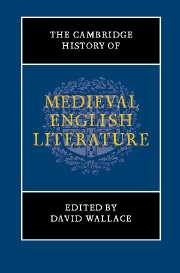Book contents
- Frontmatter
- I AFTER THE NORMAN CONQUEST
- Introduction
- 1 Old English and its afterlife
- 2 Anglo-Norman cultures in England, 1066–1460
- 3 Early Middle English
- 4 National, world and women’s history: writers and readers in post-Conquest England
- 5 Latinitas
- 6 Romance in England, 1066–1400
- II WRITING IN THE BRITISH ISLES
- III INSTITUTIONAL PRODUCTION
- IV AFTER THE BLACK DEATH
- V BEFORE THE REFORMATION
- Chronological outline of historical events and texts in Britain, 1050–1550
- Bibliography
- Index of manuscripts
- Index
- References
5 - Latinitas
from I - AFTER THE NORMAN CONQUEST
Published online by Cambridge University Press: 28 March 2008
- Frontmatter
- I AFTER THE NORMAN CONQUEST
- Introduction
- 1 Old English and its afterlife
- 2 Anglo-Norman cultures in England, 1066–1460
- 3 Early Middle English
- 4 National, world and women’s history: writers and readers in post-Conquest England
- 5 Latinitas
- 6 Romance in England, 1066–1400
- II WRITING IN THE BRITISH ISLES
- III INSTITUTIONAL PRODUCTION
- IV AFTER THE BLACK DEATH
- V BEFORE THE REFORMATION
- Chronological outline of historical events and texts in Britain, 1050–1550
- Bibliography
- Index of manuscripts
- Index
- References
Summary
Perhaps the greatest change imposed by the Norman Conquest was linguistic. We still know little of how long or deeply Normans and English were divided by their vernaculars. Latin offered a lifeline of communication at some social levels of this initially fractured society. The European clerics who arrived under Lanfranc and Anselm brought a new and different learning, and often new and deeply unwelcome religious practices such as scepticism about local saints, a celibate priesthood and newly disciplined monasticism. Despite these differences, and despite the generations-long tensions that accompanied them, clerics, whether of European or insular origin, were linked by a similar liturgy, a considerable body of shared reading, and most of all a common learned language. This unifying tongue, more over, operated well beyond the bounds of the Church, both among the surprising number of secular aristocrats who had some Latin education, and through the activities of the many clerics who served in secular law courts and other offices and cultural capacities among the laity.
At the same time, the Latin textual culture of England after 1066 had also to bridge the religious, social and cultural fissures opened by the Conquest: both the wide range of new cultural and social forces that arrived with the Normans, and the yearning of Normans and Saxons alike to inscribe continuities with the English past. This resulted in an outpouring of textual production, both in traditional and new forms, in the century-and-a-half after the Conquest.
- Type
- Chapter
- Information
- The Cambridge History of Medieval English Literature , pp. 122 - 151Publisher: Cambridge University PressPrint publication year: 1999
References
- 21
- Cited by

